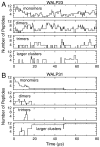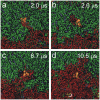Lipid packing drives the segregation of transmembrane helices into disordered lipid domains in model membranes
- PMID: 21205902
- PMCID: PMC3029762
- DOI: 10.1073/pnas.1009362108
Lipid packing drives the segregation of transmembrane helices into disordered lipid domains in model membranes
Abstract
Cell membranes are comprised of multicomponent lipid and protein mixtures that exhibit a complex partitioning behavior. Regions of structural and compositional heterogeneity play a major role in the sorting and self-assembly of proteins, and their clustering into higher-order oligomers. Here, we use computer simulations and optical microscopy to study the sorting of transmembrane helices into the liquid-disordered domains of phase-separated model membranes, irrespective of peptide-lipid hydrophobic mismatch. Free energy calculations show that the enthalpic contribution due to the packing of the lipids drives the lateral sorting of the helices. Hydrophobic mismatch regulates the clustering into either small dynamic or large static aggregates. These results reveal important molecular driving forces for the lateral organization and self-assembly of transmembrane helices in heterogeneous model membranes, with implications for the formation of functional protein complexes in real cells.
Conflict of interest statement
The authors declare no conflict of interest.
Figures




Similar articles
-
Transmembrane helices can induce domain formation in crowded model membranes.Biochim Biophys Acta. 2012 Apr;1818(4):984-94. doi: 10.1016/j.bbamem.2011.08.021. Epub 2011 Aug 22. Biochim Biophys Acta. 2012. PMID: 21884678
-
Effect of hydrophobic mismatch on domain formation and peptide sorting in the multicomponent lipid bilayers in the presence of immobilized peptides.J Chem Phys. 2014 Aug 21;141(7):074702. doi: 10.1063/1.4891931. J Chem Phys. 2014. PMID: 25149801
-
Lipid-protein interplay and lateral organization in biomembranes.Chem Phys Lipids. 2015 Jul;189:48-55. doi: 10.1016/j.chemphyslip.2015.05.008. Epub 2015 May 30. Chem Phys Lipids. 2015. PMID: 26036778 Review.
-
Understanding Membrane Domain-Partitioning Thermodynamics of Transmembrane Domains with Potential of Mean Force Calculations.J Phys Chem B. 2019 Feb 7;123(5):1009-1016. doi: 10.1021/acs.jpcb.8b10148. Epub 2019 Jan 24. J Phys Chem B. 2019. PMID: 30638009 Free PMC article.
-
Membrane simulations: bigger and better?Curr Opin Struct Biol. 2000 Apr;10(2):174-81. doi: 10.1016/s0959-440x(00)00066-x. Curr Opin Struct Biol. 2000. PMID: 10753807 Review.
Cited by
-
Dynamics of the Glycophorin A Dimer in Membranes of Native-Like Composition Uncovered by Coarse-Grained Molecular Dynamics Simulations.PLoS One. 2015 Jul 29;10(7):e0133999. doi: 10.1371/journal.pone.0133999. eCollection 2015. PLoS One. 2015. PMID: 26222139 Free PMC article.
-
The Continuing Mystery of Lipid Rafts.J Mol Biol. 2016 Dec 4;428(24 Pt A):4749-4764. doi: 10.1016/j.jmb.2016.08.022. Epub 2016 Aug 26. J Mol Biol. 2016. PMID: 27575334 Free PMC article. Review.
-
Reduced level of docosahexaenoic acid shifts GPCR neuroreceptors to less ordered membrane regions.PLoS Comput Biol. 2019 May 20;15(5):e1007033. doi: 10.1371/journal.pcbi.1007033. eCollection 2019 May. PLoS Comput Biol. 2019. PMID: 31107861 Free PMC article.
-
Efficient calculation of the free energy for protein partitioning using restraining potentials.Biophys J. 2023 Jun 6;122(11):1914-1925. doi: 10.1016/j.bpj.2022.07.031. Epub 2022 Aug 12. Biophys J. 2023. PMID: 35962549 Free PMC article.
-
Effects of Periplasmic Chaperones and Membrane Thickness on BamA-Catalyzed Outer-Membrane Protein Folding.J Mol Biol. 2017 Nov 24;429(23):3776-3792. doi: 10.1016/j.jmb.2017.09.008. Epub 2017 Sep 15. J Mol Biol. 2017. PMID: 28919234 Free PMC article.
References
-
- Lingwood D, Simons K. Lipid rafts as a membrane-organizing principle. Science. 2010;327:46–50. - PubMed
-
- Simons K, Ikonen E. Functional rafts in cell membranes. Nature. 1997;387:569–572. - PubMed
-
- Eggeling C, et al. Direct observation of the nanoscale dynamics of membrane lipids in a living cell. Nature. 2009;457:1159–1162. - PubMed
-
- Edidin M. The state of lipid rafts: From model membranes to cells. Annu Rev Biophys Biomol Struct. 2003;32:257–283. - PubMed
Publication types
MeSH terms
Substances
LinkOut - more resources
Full Text Sources
Other Literature Sources

